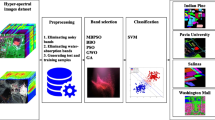Abstract
A hybrid feature selection and classification strategy was proposed based on the simulated annealing genetic algorithm and multiple instance learning (MIL). The band selection method was proposed from subspace decomposition, which combines the simulated annealing algorithm with the genetic algorithm in choosing different cross-over and mutation probabilities, as well as mutation individuals. Then MIL was combined with image segmentation, clustering and support vector machine algorithms to classify hyperspectral image. The experimental results show that this proposed method can get high classification accuracy of 93.13% at small training samples and the weaknesses of the conventional methods are overcome.
Similar content being viewed by others
References
WEI Di, CRAWFORD M M. Active learning via multi-view and local proximity co-regularization for hyperspectral image classification [J]. IEEE Journal of Selected Topics in Signal Processing, 2011, 5(3): 618–628.
MELGANI F, BRUZZONE L. Classification of hyperspectral remote sensing images with support vector machines [J]. IEEE Transactions on Geoscience and Remote Sensing, 2004, 42(8): 1778–1790.
CAMPS-VALLS G, BRUZZONE L. Kernel-based methods for hyperspectral image classification [J]. IEEE Transactions on Geoscience and Remote Sensing, 2005, 43(6): 1351–1362.
CAMPS-VALLS G, GÓMEZ-CHOVA L, CALPE-MARAVILLA J, MARTÍN-GUERRERO J D, SORIA-OLIVAS E, ALONSO-CHORDÁ L, MORENO J. Robust support vector method for hyperspectral data classification and knowledge discovery [J]. IEEE Transactions on Geoscience and Remote Sensing, 2004, 42(7): 1530–1542.
LI Shi-jin, WU Hao, WAN Ding-sheng, ZHU Jia-li. An effective feature selection method for hyperspectral image classification based on genetic algorithm and support vector machine [J]. Knowledge-Based Systems, 2011, 24(1): 40–48.
ZHANG Ye, DESAI M D, ZHANG Jun-ping, JIN Ming. Adaptive subspace decomposition for hyperspectral data dimensionality reduction [C]// IEEE International Conference on Image Processing. Kobe, Japan: IEEE Press, 1999: 326–329.
HUANG Yi-heng, ZHANG Wen-sheng, WANG Jue. Multiple instance learning with correlated features [J]. International Journal of Fuzzy Systems, 2012, 14(2): 305–313.
WANG Shi-jun, MCKENNA M T, NGUYEN T B, BURNS J E, PETRICK N, SAHINER B, SUMMERS R M. Seeing is believing: Video classification for computed tomographic colonography using multiple-instance learning [J]. IEEE Transactions on Medical Imaging, 2012, 31(5): 1141–1153.
RAYKAR V C, KRISHNAPURAM B, BI J B, DUNDAR M, RAO R B. Bayesian multiple instance learning: Automatic feature selection and inductive transfer [C]// Proceedings of the 25th International Conference on Machine Learning. New York, USA: Association for Computing Machinery, 2008: 808–815.
BOLTON J, GADER P. Multiple instance learning for hyperspectral image analysis [C]// Geoscience and Remote Sensing Symposium. Gainesville, New York: IEEE Press, 2010: 4232–4235.
TORRIONE P, RATTO C, COLLINS L. Multiple instance and context dependent learning in hyperspectral data [C]// IEEE Workshop on Hyperspectral Image Signal Process: Evolution Remote Sensing. Durham: IEEE Press, 2009: 1–4.
ZHANG Jun-ping, ZHANG Ye, ZOU Bin, ZHOU Ting-xian. Fusion classification of hyperspectral image based on adaptive subspace decomposition [C]// IEEE Signal Processing Society. Canada: IEEE Press, 2000: 472–475.
LIANG F M, WONG W H. Evolutionary Monte Carlo: Applications to C-p model sampling and change point problem [J]. Statistical Sinica, 2000, 10(2): 317–342.
WANG C M, HYMAN J D, PERCUS A, CAFLISCH R. Parallel tempering for the traveling salesman problem [J]. International Journal of Modern Physics C, 2009, 20(4): 539–556.
HUANG Jiang-hua, ZHANG Jun-ying. Distributed dual cluster algorithm based on FCM-Clustering sensor streams [J]. Information-An International Interdisciplinary Journal, 2012, 15(8): 3401–3410.
YU Jian, YANG Min-shen. Optimality test for generalized FCM and its application to parameter selection [J]. IEEE Transactions on Fuzzy Systems, 2005, 13(1): 164–176.
TARABALKA Y, FAUVEL M, CHANUSSOT J, BENEDIKTSSON J A. SVM- and MRF-based method for accurate classification of hyperspectral images [J]. IEEE Geoscience and Remote Sensing Letters, 2010, 7(4): 736–740.
DU Pei-jun, TAN Kun, XING Xiao-shi. Wavelet SVM in reproducing Kernel Hilbert space for hyperspectral remote sensing image classification [J]. Optics Communications, 2010, 283(24): 4978–4984.
HUANG C Q, SONG K, KIM S, TOWNSHEND J R G, DAVIS P, MASEK J G, GOWARD S N. Use of a dark object concept and support vector machines to automate forest cover change analysis [J]. Remote Sensing of Environment, 2008, 112(3): 970–985.
TUIA D, RATLE F, PACIFICI F, KANEVSKI M, EMERY W J. Active learning methods for remote sensing image classification [J]. IEEE Transactions on Geoscience and Remote Sensing, 2009, 47(7): 2218–2232.
HAM J, CHEN Y C, CRAWFORD M M, GHOSH J. Investigation of the random forest framework for classification of hyperspectral data [J]. IEEE Transactions on Geoscience and Remote Sensing, 2005, 43(3): 492–501.
ZHANG Bing, LI Shan-shan, JIA Xiu-ping, GAO Lian-ru, PENG Man. Adaptive Markov random field approach for classification of hyperspectral imagery [J]. IEEE Geoscience and Remote Sensing Letters, 2011, 8(5): 973–977.
MITRA P, SHANKAR B U, PAL S K. Segmentation of multispectral remote sensing images using active support vector machines [J]. Pattern Recognition Letters, 2004, 25(9): 1067–1074.
LI Shan-shan, ZHANG Bing, CHEN Dong-mei, GAO Lian-ru, PENG Man. Adaptive support vector machine and Markov random field model for classifying hyperspectral imagery [J]. Journal of Applied Remote Sensing, 2011, 5 (053538): 1–10.
ANDREWS S, TSOEHANTARIDIS I, HOFMANN T. Support vector machines for multiple-instance learning [M]. Proceedings of Advances in Neural Information Processing Systems. Cambridge, MA: MIT Press, 2003: 561–568.
Author information
Authors and Affiliations
Corresponding author
Rights and permissions
About this article
Cite this article
Gao, Hm., Zhou, H., Xu, Lz. et al. Classification of hyperspectral remote sensing images based on simulated annealing genetic algorithm and multiple instance learning. J. Cent. South Univ. 21, 262–271 (2014). https://doi.org/10.1007/s11771-014-1937-0
Received:
Accepted:
Published:
Issue Date:
DOI: https://doi.org/10.1007/s11771-014-1937-0




